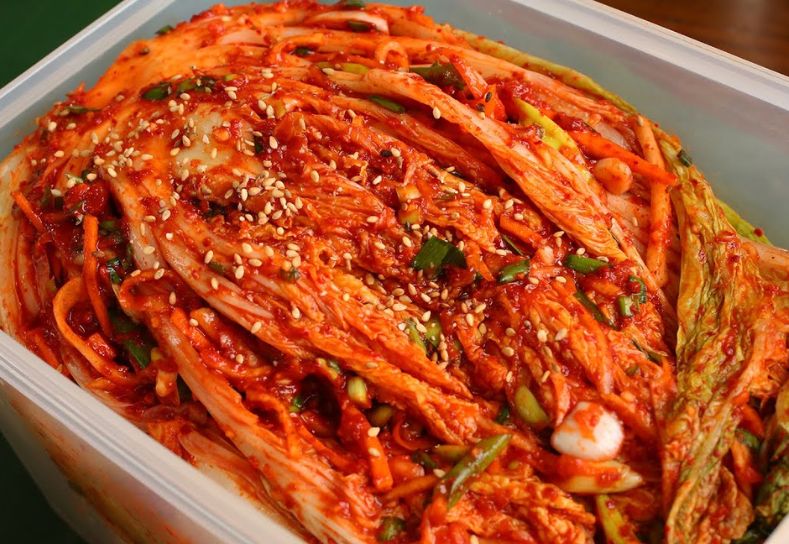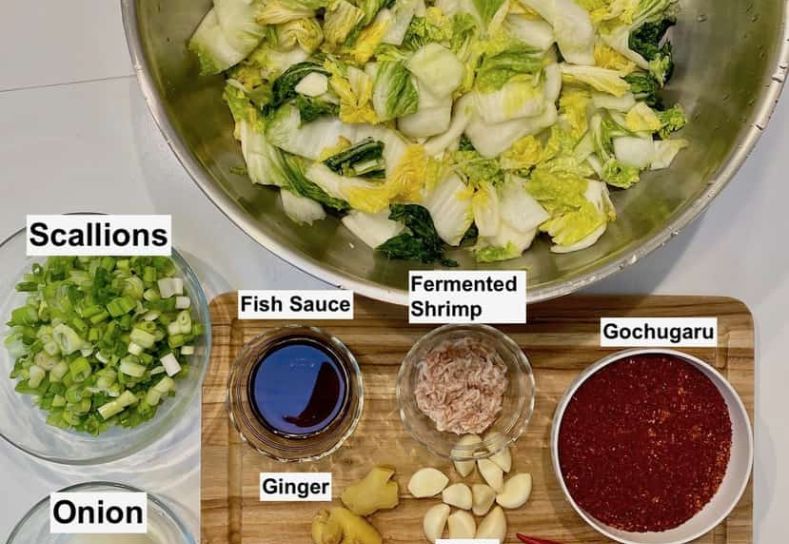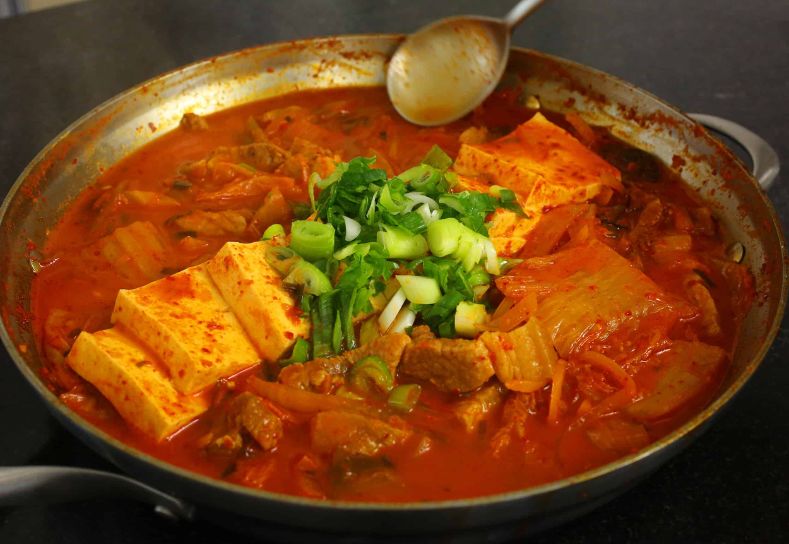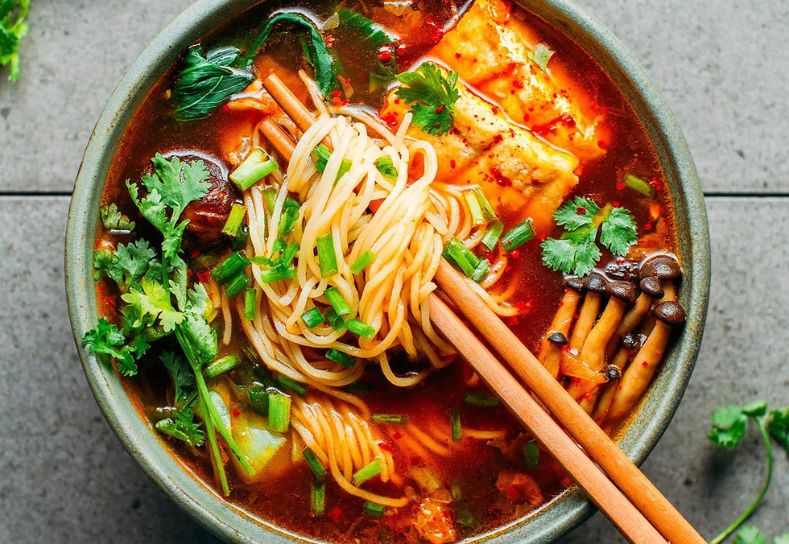kimchi Recipe -Kimchi, a traditional Korean dish, is a spicy, tangy, and fermented side dish made primarily from Napa cabbage and a variety of seasonings. This beloved condiment has gained popularity globally for its unique flavor profile and numerous health benefits. As a staple in Korean cuisine, kimchi has a rich history and cultural significance, making it a cherished part of Korean meals and celebrations. In this comprehensive guide, we will delve into the art of making kimchi at home, exploring the steps and ingredients required to create this flavorful and probiotic-rich delicacy.
Contents
Kimchi Recipe

Ingredients:
1)1 medium-sized Napa cabbage
2)1/4 cup sea salt
3)4 cups water
4)1 tablespoon grated ginger
5)4 cloves garlic, minced
6)2 tablespoons fish sauce (or soy sauce for a vegetarian version)
7)1 tablespoon sugar
8)3 tablespoons Korean red pepper flakes (gochugaru)
9)2 to 3 green onions, thinly sliced
10)1 carrot, julienned
11)Optional: radish, daikon, or other vegetables for added variety
Instructions:
1)Prepare the Cabbage: Cut the Napa cabbage lengthwise into quarters and remove the core. Rinse the cabbage thoroughly under running water. In a large bowl, dissolve the sea salt in water to create a brine. Submerge the cabbage quarters in the brine, making sure they are fully soaked. Cover with a plate or weight to keep the cabbage submerged. Let it sit for 2 to 3 hours to soften.
2)Prepare the Kimchi Paste: In a separate bowl, combine grated ginger, minced garlic, fish sauce (or soy sauce), sugar, and Korean red pepper flakes (gochugaru). Mix well to form a thick and spicy paste.
3)Rinse and Drain the Cabbage: After soaking, rinse the cabbage under cold water to remove excess salt. Squeeze out any excess water and let the cabbage drain thoroughly.
4)Coat the Cabbage: Using gloves, spread the kimchi paste on each cabbage leaf, making sure it is evenly coated. Optionally, you can add julienned carrots, sliced green onions, and other vegetables to each layer for added flavors and textures.
5)Ferment the Kimchi: Once the cabbage is coated with the kimchi paste and additional vegetables, tightly roll each quarter and place them in an airtight container. Let the kimchi ferment at room temperature for 1 to 2 days, depending on the desired level of fermentation. Then, store it in the refrigerator to slow down the fermentation process and enhance its flavor.
6)Enjoy Your Homemade Kimchi: Your homemade kimchi is now ready to be savored! It can be served as a side dish, added to various Korean dishes, or enjoyed on its own.
Ingredients for Kimchi Recipe
Kimchi, a traditional Korean dish, has become a beloved staple in cuisines around the world, including in Malaysia. This fermented side dish is made from a variety of vegetables, with Napa cabbage being the most popular base. In Malaysia, the availability of ingredients may vary, but it’s still possible to create a delicious and flavorful kimchi with a Malaysian twist. In this guide, we will explore the essential ingredients for making kimchi in Malaysia, ensuring that you can enjoy the bold and tangy flavors of this iconic dish right in your Malaysian kitchen.
1)Napa Cabbage: Napa cabbage serves as the main vegetable for traditional kimchi. It has a mild flavor and tender texture that works well with the kimchi paste.
2)Korean Red Pepper Flakes (Gochugaru): Gochugaru is a crucial ingredient in kimchi, providing the signature spicy kick and vibrant red color. While Korean red pepper flakes are ideal, you can use Malaysian chili flakes as a substitute.
3)Garlic: Garlic adds depth and aromatic flavor to kimchi. Use fresh garlic cloves, minced or crushed, to infuse the kimchi paste.
4)Ginger: Fresh grated ginger adds a zesty and warm note to the kimchi, enhancing its overall flavor profile.
5)Fish Sauce (or Soy Sauce for Vegetarian Version): Fish sauce contributes umami and depth to the kimchi. If you prefer a vegetarian option, you can use soy sauce instead.
6)Sea Salt: Sea salt is used to create a brine for soaking the cabbage, helping to soften it and remove excess water.
7)Sugar: A small amount of sugar balances the spiciness and enhances the fermentation process.
8)Vegetables: Apart from Napa cabbage, you can add other vegetables like green onions, carrots, radish, daikon, or any other locally available vegetables to provide additional flavors and textures.
kimchi Fried Rice Recipe
Kimchi fried rice, known as “Kimchi Bokkeumbap” in Korean, is a flavorful and satisfying dish that combines the tangy goodness of kimchi with the comforting flavors of fried rice. This popular Korean street food has become a favorite among locals and food enthusiasts worldwide for its simplicity, versatility, and delightful taste. Kimchi fried rice is an excellent way to use leftover rice and leftover kimchi, transforming them into a delicious and hearty meal. In this comprehensive guide, we will explore the art of making kimchi fried rice, step by step, to enjoy the mouthwatering fusion of Korean flavors.
Ingredients:
1)2 cups cooked rice (preferably day-old rice for better texture)
2)1 cup well-fermented kimchi, chopped
3)150g thinly sliced pork belly or bacon (can be substituted with tofu for a vegetarian version)
4)1 tablespoon gochujang (Korean red pepper paste)
5)1 tablespoon soy sauce
6)1 tablespoon sesame oil
7)2 cloves garlic, minced
8)1 small onion, finely chopped
9)1/2 cup frozen mixed vegetables (carrots, peas, corn)
10)2 green onions, chopped (save some for garnish)
11)1 tablespoon vegetable oil
12)Sesame seeds and nori strips for garnish (optional)
13)Fried eggs (optional, for serving on top)
Instructions:
1)Preparation: If using day-old rice, break up any clumps and fluff the rice with a fork to ensure separate grains. Chop the kimchi into small pieces if not already done. Slice the pork belly or bacon into thin strips.
2)Sauté the Ingredients: In a large skillet or wok, heat the vegetable oil over medium-high heat. Add the minced garlic and chopped onions, and cook until the onions become translucent.
3)Add the Pork (or Tofu): If using pork or bacon, add it to the skillet and stir-fry until it’s cooked through and lightly browned. If using tofu, you can add it later after the kimchi.
4)Incorporate the Kimchi: Add the chopped kimchi to the skillet and stir-fry with the pork (if using tofu, add it now). Let the kimchi cook for a few minutes to release its flavors and become slightly caramelized.
5)Add Seasonings: Mix in the gochujang, soy sauce, and sesame oil to the kimchi mixture, ensuring everything is well-coated and evenly seasoned.
6)Add Rice and Vegetables: Add the cooked rice to the skillet, breaking up any clumps, and stir-fry it with the kimchi and pork until the rice is fully coated with the kimchi mixture. Incorporate the frozen mixed vegetables and chopped green onions, continuing to stir-fry until everything is heated through.
7)Serve and Garnish: Once the kimchi fried rice is thoroughly heated, it’s ready to be served. Optionally, top each serving with a fried egg and garnish with chopped green onions, sesame seeds, and nori strips for an extra touch of flavor and presentation.
Kimchi Jjigae Recipe
Kimchi jjigae, a popular Korean stew, is a comforting and flavorful dish that exemplifies the heart of Korean home cooking. This traditional stew features kimchi as its star ingredient, infusing the broth with its signature tangy and spicy flavors. Kimchi jjigae is a hearty and soul-warming meal that brings families and friends together, making it a beloved staple in Korean households. In this comprehensive guide, we will explore the art of making kimchi jjigae, step by step, to immerse ourselves in the rich and savory essence of this beloved Korean comfort food.
Ingredients:
1)2 cups well-fermented kimchi (sour kimchi works best)
2)200g thinly sliced pork belly or shoulder (can be substituted with tofu for a vegetarian version)
3)1 small onion, thinly sliced
4)2-3 garlic cloves, minced
5)1 tablespoon gochujang (Korean red pepper paste)
6)1 tablespoon gochugaru (Korean red pepper flakes)
7)1 tablespoon soy sauce
8)1 teaspoon sesame oil
9)1 teaspoon sugar
10)4 cups water or anchovy-kelp broth (for deeper flavor)
11) green onion, chopped (for garnish)
12)Optional: 1/2 cup sliced mushrooms, 1/2 cup sliced zucchini, or other vegetables of choice
Instructions:
1)Prepare the Kimchi: Chop the kimchi into bite-sized pieces if necessary. Well-fermented kimchi with a tangy and sour flavor is ideal for kimchi jjigae, as it provides the best depth of taste.
2)Sauté the Ingredients: In a large pot or Korean earthenware pot (ttukbaegi), heat a drizzle of sesame oil over medium heat. Add the thinly sliced pork belly or tofu and sauté until lightly browned.
3)Add the Aromatics: Stir in the minced garlic and sliced onions, and cook until the onions become translucent.
4)Create the Flavor Base: Mix in the gochujang, gochugaru, soy sauce, and sugar to create the spicy and savory flavor base for the stew. Stir everything together until well combined.
5)Add the Kimchi and Broth: Add the chopped kimchi and any optional vegetables to the pot. Pour in the water or anchovy-kelp broth to cover the ingredients and bring the stew to a gentle simmer.
6)Simmer and Let the Flavors Infuse: Allow the kimchi jjigae to simmer over low to medium heat for about 20-30 minutes, or until the flavors have melded together, and the vegetables are tender.
7)Serve and Garnish: Once the stew is ready, serve it piping hot in individual bowls. Garnish with chopped green onions for a fresh and aromatic touch.
Kimchi Soup Recipe
Kimchi soup, known as “Kimchi Jjigae” in Korean, is a hearty and comforting dish that exemplifies the soul of Korean home cooking. This traditional Korean soup features the bold flavors of kimchi, combined with various proteins and vegetables, creating a rich and tangy broth that warms the heart and soul. Kimchi jjigae is a popular dish enjoyed year-round, especially during cold weather, as its spicy and robust taste provides a comforting and invigorating experience. In this comprehensive guide, we will explore the art of making kimchi soup, step by step, to immerse ourselves in the delightful and aromatic essence of this beloved Korean comfort food.
Ingredients:
1)2 cups well-fermented kimchi, chopped
2)150g thinly sliced pork belly or shoulder (can be substituted with tofu for a vegetarian version)
3)1 tablespoon gochugaru (Korean red pepper flakes)
4)1 tablespoon gochujang (Korean red pepper paste)
5)1 tablespoon soy sauce
6)1 tablespoon sesame oil
7)2 cloves garlic, minced
8)1 small onion, thinly sliced|
9)1 tablespoon vegetable oil
10)4 cups water or anchovy-kelp broth (for deeper flavor)
11)1 cup sliced mushrooms (shiitake or oyster mushrooms work well)
12)1 block firm tofu, cubed
13)2 green onions, chopped (save some for garnish)
14)1 tablespoon kimchi juice (optional, for extra tanginess)
15)1 tablespoon fish sauce (optional, for added umami)
16)Salt and pepper, to taste
Instructions:
1)Prepare the Kimchi: Chop the well-fermented kimchi into bite-sized pieces. The sour and tangy flavor of well-fermented kimchi works best for kimchi soup, as it provides a depth of taste to the broth.
2)Sauté the Ingredients: In a large pot or Korean earthenware pot (ttukbaegi), heat the vegetable oil over medium heat. Add the minced garlic and thinly sliced onions, and cook until the onions become translucent.
3)Add the Pork (or Tofu): If using pork, add it to the pot and stir-fry until it’s cooked through and lightly browned. If using tofu, you can add it later after the kimchi.
4)Incorporate the Kimchi: Add the chopped kimchi to the pot and stir-fry with the pork (if using tofu, add it now). Let the kimchi cook for a few minutes to release its flavors and become slightly caramelized.
5)Create the Flavor Base: Mix in the gochugaru, gochujang, soy sauce, and sesame oil to the kimchi mixture, ensuring everything is well-coated and evenly seasoned.
6)Add Broth and Vegetables: Pour in the water or anchovy-kelp broth to cover the ingredients in the pot. Add the sliced mushrooms and cubed tofu, stirring everything together to incorporate the flavors.
7)Simmer and Adjust Seasoning: Let the kimchi soup simmer over low to medium heat for about 20-30 minutes, allowing the flavors to meld together and the tofu and vegetables to become tender. Taste the broth and adjust the seasoning with salt, pepper, kimchi juice, or fish sauce according to your preference.
8)Serve and Garnish: Once the kimchi soup is ready, serve it hot in individual bowls. Garnish with chopped green onions for a fresh and aromatic touch.




